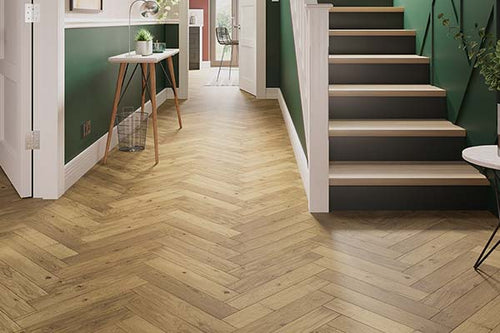In interior design, layering is the key to creating rooms with depth and character. It takes different elements of your space – think lighting, flooring, furniture, art, and textiles – and combines them for a cohesive home with plenty of interest. It’s also the perfect way to transform a purely functional kitchen into one that reflects your individual aesthetic.
For this guide, we’ve partnered with Hillarys, the window dressing specialists, to compile the very best tips for layering in your kitchen. Master the art of conscious interior design and bring your home to life.
Start From the Ground Up
Layering in a kitchen starts at ground level, with your flooring. This is an excellent base to begin working with textures, and a beautiful floor can ground your interiors and set the tone.

Natural flooring often brings the most interest in terms of texture. Explore real wood for a warm, rustic aesthetic that can be easy to work with for beginner designers. Contemporary kitchens will benefit from cooler textures, like concrete tiles or stone-effect flooring, both of which provide a minimalist base for modern spaces.
“People often think of flooring as a backdrop, but in reality, it’s the anchor that every other design choice rests on. The colour, texture, and material you choose for your kitchen floor will influence how light behaves in the space, how warm or cool the room feels, and even how durable your design will be over time. Get the flooring right, and layering the rest of your kitchen becomes effortless” - Chelsea Johnson, E-commerce manager at UK Flooring Direct
As your floors and counters tend to use hard materials, look for opportunities to soften your aesthetic and layer different textures throughout your kitchen. This includes functional textiles, like your blinds. Hillarys offers made to measure blinds in a range of soft fabrics, including velvet and boucle.
You can add texture with table mats, cloths, napkins, and rugs, too. In country-style cottage kitchens, you might even see cabinet doors replaced with curtains, which is a fantastic way to bring a soft, cosy vibe to vintage-inspired spaces.
Crafting Your Colour Palette
A layered colour palette should be made up of multiple complementary tones, tied together with one main colour you use for your walls. If you’re playing it safe, white is the perfect choice for a blank canvas. This includes off-whites and those with slightly different undertones, like yellow and blue-toned whites. Your layering will then rely on pops of colours in your décor, appliances, and furniture. Your flooring choice also plays a key role here — lighter oak or pale stone floors can brighten a scheme and keep it feeling airy, while darker tones like walnut or slate can ground bolder shades and add depth. For a bolder look, consider beginning your kitchen layering with a standout colour for your walls, tiles, or cabinets.
If you’re playing it safe, white is the perfect choice for a blank canvas. This includes off-whites and those with slightly different undertones, like yellow and blue-toned whites. Your layering will then rely on pops of colours in your decor, appliances, and furniture.
For a bolder look, consider beginning your kitchen layering with a standout colour for your walls, tiles, or cabinets. The rest of your decor and layering should be in complementary tones. For instance, if you choose an earthy, rust red for your walls, you can layer in accents of gold, softer pinks, and sage green for a more dynamic space.
Master the Art of Layered Lighting
Lighting plays one of the most important roles in creating a layered kitchen design. A single overhead light doesn’t bring too much character or visual interest. We recommend working with multiple options to improve the functionality of your room, create a clear flow, and achieve a bolder look.
Start with your main light. This could be ceiling pendants or recessed spotlights, for instance. Next, consider task lighting to add a practical, contemporary vibe to your kitchen. You might opt for under-cabinet lights, strip LEDs beneath shelving, or floor spotlights, depending on what you need from your space.
Yvonne Keal from Hillarys says, “Blinds are a key part of layered lighting in the kitchen, working alongside pendants, spotlights, and under-cabinet lights to create the right mood. Day & night blinds or sheer roller blinds are ideal for filtering and softening natural light throughout the day, allowing you to adjust the light levels to complement your artificial lighting.”

You can then add accent lighting to bring warmth and character. If you have a contemporary kitchen island, for instance, installing pendants above it is a great way to draw the eye to this space and create clear zones (an interior design concept we’ll explore further in the next section).
For open plan lighting, bring ambience with plenty of lamps. You can also add wall sconces for lower-level lighting and a cosy kitchen, perfect for enjoying a cuppa before bed or a glass of wine with friends.
Create Zones in Your Space
Creating zones is a popular interior design strategy that brings a flow to dynamic, versatile spaces, like kitchens. It’s also a fantastic method of layering that grounds your decisions in the function of particular areas.
Think about your room in terms of activity hubs. You might have a prep zone for cooking, a cleaning zone around the sink, and a social zone near your dining area. You can use your decor and furnishings to make these specific areas clearer, while bringing cohesion to your overall space.
Some top ideas for layering while adding zones include:
- Use a runner rug in front of your sink for a softer, cosy aesthetic.
- Group functional accessories, like wooden chopping boards and utensils, on your counters (your cooking zone).
- Group your coffee machine and jars of tea and coffee to create a distinct drinks area.
- Use lighting to signify different moods and purposes within your areas.
By layering your kitchen and developing zones, you create a space that feels intuitive to use, with each area flowing naturally into the next.
Use Your Kitchen Walls
Kitchen designs often focus on your flooring, counters, and cabinets, but what about your walls?
Bare spaces on your walls bring a great opportunity not only for layering, but also for adding to the function of your space. In small kitchens, using your walls is a practical must-have, while in larger kitchens, it’s a brilliant way to introduce character.
Start by assessing how you can use your walls. If you’re lacking cupboard space, for instance, a couple of shelves will bring more storage room for jarred goods. Use varying sizes of jars and fill them with a variety of different coloured dried foods to add plenty of interest to your shelves.
If you’re into the cottagecore aesthetic, pan hooks are another handy feature for hanging your frying pans, skillets, and kitchen utensils while saving on cupboard space.
Walls can also be a place to express your personal style and layer colour. Hang art on your walls, pop up a chalkboard you can use for meal plans, and add herb planters to hooks beneath your shelving.
Add Decorative Accessories
You’ve sorted your flooring, colour palette, and zones; now it’s time to decorate. Look at ways you can blend form and function with your decor. You might add a rustic wooden spice rack and vintage spice jars to your worktop, for instance, alongside a vase of wild flowers. Cookbooks on your shelves or counters are an excellent addition, too, as is a decorative jar for your best utensils.
The trick here is to add life without bringing clutter. We recommend a few statement pieces that suit your aesthetic, and grouping items by the rule of 3 for a cohesive look.
Blend different textures, heights, and colours for added visual interest. For instance, you might group a cookbook, a jar of decanted olive oil, and a pot of salt for a practical but pretty arrangement.
Final Thoughts
Creating a stylish kitchen is all about decorating with intention. From the texture of your flooring and blinds to the items you group together on your counters, each choice should work together to create a space that feels lively and dynamic, yet clearly cohesive.
Looking for more tips on decorating your home? Check out our flooring and home decor advice.



